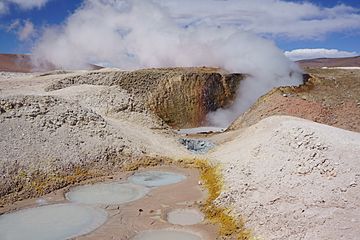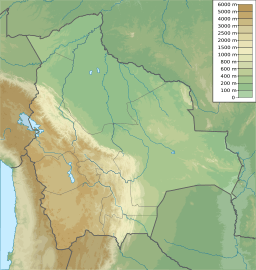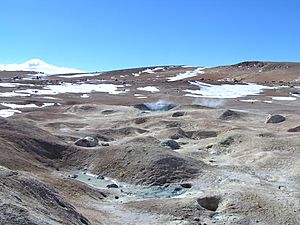Sol de Mañana facts for kids
Quick facts for kids Sol de Mañana |
|
|---|---|
 |
|
| Highest point | |
| Geography | |
Sol de Mañana is a special place in southern Bolivia. It has lots of natural hot spots, like steam vents, hot springs, and bubbling mud pools. This is called geothermal activity.
The area is very high up, about 4,900 meters (16,076 feet) above sea level. It's located south of Laguna Colorada and east of the El Tatio hot springs. Sol de Mañana is part of the Eduardo Avaroa Andean Fauna National Reserve. It's a popular spot for tourists traveling between Uyuni and Antofagasta. Scientists have been studying Sol de Mañana since the 1970s to see if it can be used to make geothermal power. This work is still happening today.
Contents
What is Sol de Mañana?
Sol de Mañana is in a quiet, empty part of Bolivia. It covers an area of about 10 square kilometers (3.8 square miles). Here, you can find many amazing natural features:
- Steam vents
- Mud pools
- Hot springs
- Geysers
- Fumaroles (steam and gas vents)
Sometimes, the steam and water can shoot up to 200 meters (656 feet) high! The gas coming out often contains sulfur, which smells like rotten eggs. The hot springs can reach temperatures of 30°C (86°F). The fumaroles are even hotter, at 70°C (158°F). They are so hot that satellites can see them from space!
Sometimes, small earthquakes happen in the area. Sol de Mañana is one of the highest geothermal fields in the world.
The closest towns are Quetena Grande and Quetena Chico. They are about 75 kilometers (47 miles) away. You can reach Sol de Mañana by unpaved roads from Uyuni, which is 340 kilometers (211 miles) away.
Just 30 kilometers (19 miles) away in Chile is El Tatio. This is another famous geothermal area. There are many volcanoes nearby, like Tocorpuri, Putana, and Escalante. The area is also close to Laguna Colorada, a beautiful red lake. There are also mines a few kilometers south of Sol de Mañana.
How the Earth Works Here
The Earth's surface is made of huge pieces called tectonic plates. Off the coast of South America, one plate (the Nazca Plate) slides under another (the South American Plate). This process is called subduction. It causes the many volcanoes you see in the Andes Mountains.
The Andes have four main areas with volcanoes. The volcanoes in this part of the Andes started forming about 23 million years ago. They created huge layers of volcanic rock called ignimbrites. These layers form one of the biggest volcanic plateaus in the world. Later, many younger volcanoes grew on top of these layers. There are about 150 separate volcanoes here!
The dry climate in this region helps to keep the volcanic landforms looking almost new. About 50 volcanoes in this part of the Andes have been active in the last 10,000 years.
Local Geology
Sol de Mañana is part of the Laguna Colorada volcanic area. The rocks here are from volcanoes that were active between 5 million and 1.2 million years ago. These include volcanic ash and lava. There are also areas with river deposits and moraines (rocks left by glaciers).
The ground in this area has many cracks, called faults. These faults run in different directions. At Sol de Mañana, some faults are still active today. They act like pathways, allowing hot water from deep underground to rise to the surface.
Scientists have drilled deep into the ground at Sol de Mañana. They found different layers of rock, including volcanic ash and lava. Hot water has changed these rocks over time. This process is called hydrothermal alteration.
The heat for Sol de Mañana comes from very hot rock deep inside the Earth. This heat rises through the ground in a process called convection. It creates two underground areas of hot water, like giant hot water tanks. These tanks are covered by a layer of clay. Rainwater seeps into the ground and reaches these hot water tanks through the deep faults.
Drilling has shown that these underground hot water tanks can reach temperatures of about 250-260°C (482-500°F). Some scientists think that Sol de Mañana and El Tatio (the hot springs in Chile) might be connected underground. Sol de Mañana would be closer to the main heat source.
Weather and Wildlife
The area around Sol de Mañana is very dry. It gets only about 75 millimeters (3 inches) of rain each year. The average temperature is about 8.9°C (48°F).
As mentioned, this geothermal field is part of the Eduardo Avaroa Andean Fauna National Reserve. It's one of the main tourism spots for people traveling between Uyuni and Antofagasta.
Making Power from Earth's Heat
The 1973 oil crisis made countries look for new ways to make energy. Bolivia started to explore its geothermal power resources. They focused on areas like Sol de Mañana.
A project to develop geothermal power began in 1978. Many drilling tests were done. But the project stopped in 1993 because of legal and political issues.
In 2010, the project started again with help from Japan. More drilling was done. As of 2023, the project is still in its early stages. In 2016, the heat from Sol de Mañana was only used to help with mining at the San Cristobal mine.
Scientists believe Sol de Mañana could produce about 50 to 100 megawatts of electricity. This is enough to power many homes!
Sol de Mañana is the main focus for geothermal power in Bolivia. Other places have not been studied as much. Developing geothermal power here is difficult because the area is so remote. It would require building long power lines to carry the electricity to cities. Also, electricity prices in Bolivia are low, which makes it harder to make money from such a big project.
See also
 In Spanish: Sol de Mañana para niños
In Spanish: Sol de Mañana para niños




